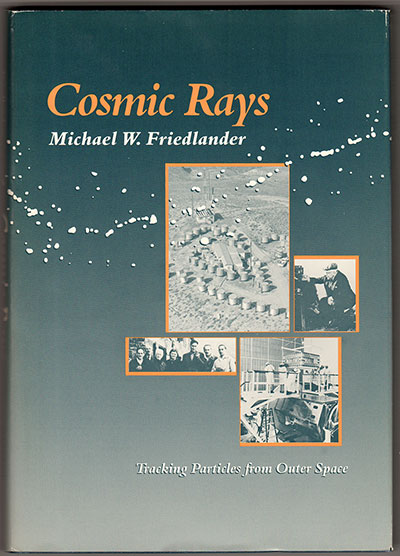Book: Cosmic Rays: Tracking Particles from Outer Space

Cosmic Rays: Tracking Particles from Outer Space cover
Harvard University Press, 1989.
Publisher's blurb (dust cover notes)
Day in and day out, cosmic rays from the far reaches of space pass through our bodies, yet modern astrophysics has still to unlock all their secrets. Though many details about cosmic rays remain enigmatic, next to electromagnetic radiation they convey more information about the universe beyond the solar system than any other source. They provide us with information about energetic explosions elsewhere in our galaxy and perhaps beyond, and they tell us a great deal about the contents of our own galaxy, through which they pass in reaching us. Illustrating the beautiful symmetry of nature, they shed light on the tiny dimensions of atomic nuclei as well as the immense scale of galaxies.Friedlander's engaging tale of this peculiar rain of charged particles begins with their discovery early in this century and goes on to describe impressive attempts by a special breed of scientists--sometimes engaging in swashbuckling science at its most adventurous--to fill in the gaps in our knowledge. The central question is: Where do cosmic rays come from? Some scientists maintain that supernovas, much more massive than our sun, are largely responsible for generating them. Most of them probably originate within our Milky Way galaxy, but a few (the most energetic ones) appear to come from a much greater distance. But we still have much to learn about their origin.
The book describes scientists studying cosmic rays by all sorts of methods: satellites, space probes, high-altitude balloons and airplanes-even giant detectors two miles beneath the earth's surface. Their ingenious investigations have yielded startling insights about nature--as well as an inordinately large number of Nobel Prizes. Michael Friedlander, for many years a principal researcher of cosmic radiation, masterfully portrays how a perfect marriage between pure and applied science has forged new understandings of our physical world. This uncommonly lucid history, richly illustrated with more than 50 drawings and photographs, touches the astronomer within each of us who yearns to explore one of the great mysteries of the universe.
Table of Contents [Click triangle or this line.]
The Early DaysIdentifying Cosmic Rays
The Earth's Magnetic Influence
Particles from the Sun
Cosmic Rays in the Galaxy
The Energy Spectrum
Nuclear Clues
The Origin of Cosmic Rays
Cosmic Rays with Little or No Mass
The Subnuclear World
Footprints and Souvenirs
Reviews and Publicity
- 1990 Science Studies brochure from Harvard University Press (See second page of PDF, "p6"; blurb quote from Library Journal.)
- 1991(?) Space Studies brochure from Harvard University Press (See third page of PDF; blurb quote from British Astronomical Association.)
- Main selection (one of two) for February 1990 Astronomy Book Club (Plus an extra page from the booklet about the not-yet-launched Hublle Space Telescope, just for interest.)
- Review by Arnold Wolfendale Nature, July 1989. [DOI]
- Review by Stephen Parry
Journal of the British Astronomical Association, December 1989. [NASA ADS]
Other citations and references
- Ainsworth Books publicty blurb. Also here
- Three-dimensional Atmospheric Transport Simulation of the Radioactive Tracers 210Pb, 7Be, 10Be, and 90Sr by Stefan Rehfeld and Martin Heimann, Max-Planck Institut für Meteorologie, September 1994. [2.9PB PDF, not inline]
- Analiza radioactivitatii cosmogenice in rezervoarele geosferei ( Analysis of cosmogenic radioactivity in geosphere reservoirs (English translation of Italian original)) 2001.